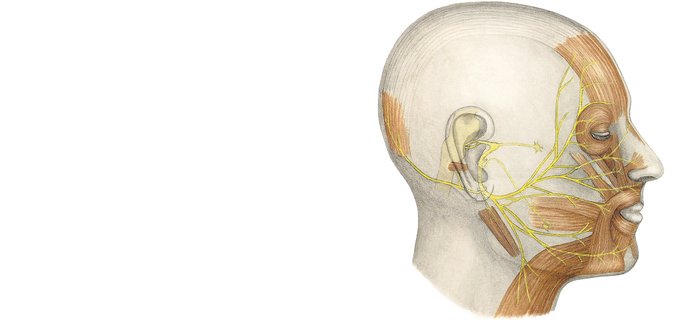Sorensen Clinic
Plastic and Reconstructive Surgery
10 Knaresborough Place
Kensington
London SW5 0TG
United Kingdom
Appointments: +44 (0) 20 7600 4444
Email: info@sorensenclinic.com
Office hours
Monday - Friday: 09.00 - 17.30

The facial nerve (7‘th cranial nerve) contains multiple (5-10.000) fine nerve cell extensions (called nerve fibres or axons). Each of these controls a sub-segment of one of more than 20 individual muscles in the face and neck. Facial nerve fibres are essential for voluntary and spontaneous facial expressions, social interaction (non-verbal-communication) and the function of mouth and eyelids.
If the facial nerve is damaged (Bell’s palsy, trauma, infection, inflammation, tumours or surgery) it has the potential for self-repair. Biological systems inside the nerve will facilitate growth of nerve fibres as they regenerate towards their original muscle-segments in order to recover function. However, scar tissue or less ideal growth conditions, may divert outgrowing nerve fibres to incorrect targets (i.e. different muscle segments, different muscle groups, or the lacrimal gland).
All severe damage to the facial nerve results in initial facial paralysis, followed by synkinesis once muscle function is regained. Various symptom patterns exist; the most disabling being related to eye-closure, oral function, facial mass-movements, muscle rigidity or hyperlacrimation (excessive tear flow).
Synkinesis affects each individual differently. Some cases are mild and do not require treatment as the symptoms gradually improve, others will benefit from a selective reduction of muscle activity.
● Physiotherapy
Muscle exercises and functional repetitions in front of a mirror can benefit all patients recovering from facial paralysis. When synkinesis develops, the exercises aim at controlling the new movement patterns. Through neuromuscular retraining both facial function and expressions can be improved several years after injury.
Botulinum toxin A is effective in providing a targeted relaxation of problematic sub-components of the facial muscles. Although the treatment in principle, requires repetition every four to five months, many patients experience a lasting improvement after a sequence of injections. In addition, transconjunctival botulinum toxin is successful in reducing tear production in the overactive lacrimal gland.
Surgical intervention (neurectomy) is occasionally indicated in severe cases of synkinesis.
Some patients are unaware that they suffer from synkinesis. Individuals with muscle rigidity whose symptoms may be misinterpreted as lack-of-recovery, may actually have well-innervated opposing muscle groups mutually blocking each other.
At the Sorensen Clinic we analyse and map the functional muscle groups. This provides the foundation for botulinium toxin treatment (or surgery if indicated). It is our experience that all patients with symptomatic synkinesis to some extent can benefit from this treatment.